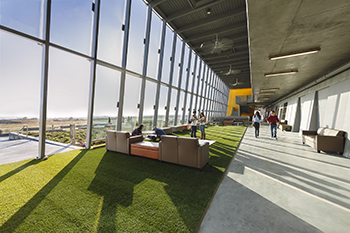 IRVINE, Calif. — Sustainability is part of the culture and history of LPA Inc. With more than 100 LEED-designed projects, green buildings are an integral part of the firm. However, LEED is not the only marker of sustainable practices, said Dan Heinfeld, president of LPA.
IRVINE, Calif. — Sustainability is part of the culture and history of LPA Inc. With more than 100 LEED-designed projects, green buildings are an integral part of the firm. However, LEED is not the only marker of sustainable practices, said Dan Heinfeld, president of LPA.
“Sustainability for us is way too important to be just a score card. We wanted to find a way to make sustainability much more broad and much more holistic to the way the company works,” he said.
For LPA, sustainability has always been motivated by the desire to be more valuable to clients. Through much collaboration, LPA has identified 10 principles of sustainable design that describe the holistic vision of green building. The principles do not specifically discuss LEED certification because many things can be done from a sustainable standpoint that do not correspond with LEED points, Heinfeld said.
“We wanted to find ways to really link design excellence with sustainability and look for the synergies between the two because we really believe they are one in the same,” Heinfeld said.
Below, LPA describes the firm’s 10 principles of sustainable design.
1. Inter + Act: Essentially, it’s taking all of the stakeholders in a project and making sure that they have a voice in the creation of the sustainable aspects of the project. This includes everyone from the users, to the maintenance personnel, to the engineers and the architects. We believe that real sustainability happens when building designers have these collaborative interactions on a day-to-day basis. These spontaneous bursts of creativity between the various architects, engineers, interior designers and landscape architects are priceless and one of the main reasons we’ve brought all of these disciplines in-house.
2. Do Less: Conservation is vital to sustainable design. It helps us minimize our footprint on the environment, protect natural resources, reduce our energy and water consumption, and it encourages design that does more with less. Doing less also saves money by finding and using what is free — or what we like to call the “gifts of the site.”
3. Challenge Convention: It’s time to start thinking outside of the box in a creative and thoughtful manner. That’s how we’re going to solve some of the big issues that we’re facing and some of the issues as they relate to water management and energy efficiency.
4. Zoom Out: This is about understanding the larger environmental issues so that you can solve those smaller problems with perspective and ease. More than ever, it is critical to understand architecture in a wider context. A macro examination of adjacent buildings, pedestrian access, roads, regional issues and environmental effects gives us clues in our search for the most appropriate design solution.
5. Zoom In: When we “zoom in,” we’re really thinking about the details of buildings, and how those details start to 1) tell and reinforce each project’s sustainable story, and 2) create a well-made product that will be in service for our clients for a long time. Each planning and design component is part of a much larger whole. Green the details and you’ll green the project.
6. Build Smart: We view sustainability and architecture as one in the same. We don’t separate or emphasize one over the other. We feel that essentially they are the same processes and, as a result, we take a very different approach to “building smart.”
7. Enrich Lives: The most sustainable building one can create is the building that people love and want to take care of and that will last for decades. This can only be achieved through great design. And that’s fundamentally what we try to accomplish here and why we believe design matters.
8. Create Value: Green architecture isn’t about added cost. It’s about added value. Start viewing the world with this outlook and you’ll have a much better understanding of the advantages — many immeasurable — that this kind of process can create. Creating value in our line of work also encompasses giving clients buildings with lower operating costs, both now and as time carries on.
9. Prove It: Provide the hard numbers that all stakeholders need about the true costs and benefits of green buildings. It’s important to prove that green buildings do not — and should not — cost more.
10. Step Up: The idea of being more sustainable has been discussed a great deal and by now we are all aware of the benefits. Step up is really a call to action. The time for green buildings, and generally more sustainable decision-making on a daily basis, is now. Everyone wants to be a part of something bigger than themselves, and living and working lighter on the environment is an easy way to build consensus, give people a mission and contribute to a more positive legacy for those to come.

